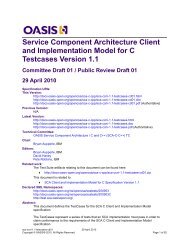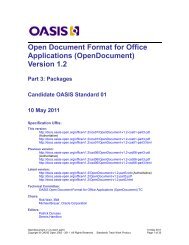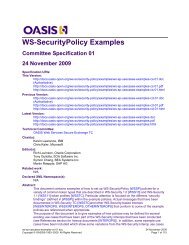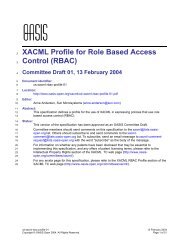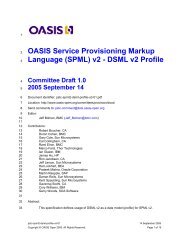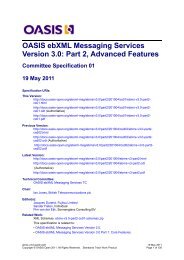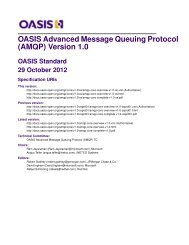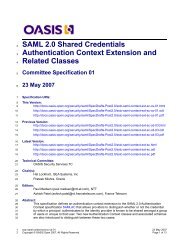Content Management Interoperability Services (CMIS) Version 1.1
Content Management Interoperability Services (CMIS) Version 1.1
Content Management Interoperability Services (CMIS) Version 1.1
Create successful ePaper yourself
Turn your PDF publications into a flip-book with our unique Google optimized e-Paper software.
2.1.9 Secondary Object-Types<br />
A secondary type defines a set of properties that can be dynamically added to and removed from objects.<br />
That is, an object can get and lose additional properties that are not defined by its primary type during its<br />
lifetime. Multiple secondary types can be applied to the same object at the same time.<br />
Secondary types can be simple markers without properties. Alternatively, they can contain technical information<br />
about an object. For example, a repository might analyze the content of a document, detects a<br />
photo and adds a secondary type that adds EXIF data to the document. Applications might want to attach<br />
temporary data to an object such the state of the object in a workflow. Secondary types may also change<br />
the behaviour of the repository.<br />
The <strong>CMIS</strong> specification does not define the semantics of secondary types with the exception of secondary<br />
types for retentions and holds (see section 2.<strong>1.1</strong>6 Retentions and Holds). <strong>CMIS</strong> provides a way to apply<br />
and remove secondary types to/from an object. Additionally, <strong>CMIS</strong> provides an optional ability to create,<br />
update and remove secondary types.<br />
If a repository does not support secondary types, the secondary type base object-type cmis:secondary<br />
SHOULD NOT be returned by a getTypeChildren service call.<br />
The base object-type does not specify any property definitions and its sole purpose is to be the root type of<br />
all other secondary object-types. Repositories MAY provide property definitions on the base type that are<br />
then inherited by other secondary object-types.<br />
Secondary types can be applied to and removed from an object at any time. An object MAY have zero or<br />
more secondary types assigned to it. When a secondary type is applied, the object provides the properties<br />
that are defined by the secondary type. When a secondary type is removed, it loses these properties and<br />
its values.<br />
A repository MAY not allow applying or removing certain secondary object-types to certain objects based on<br />
rules that are not determined in this specification. The repository SHOULD throw a constraint exception<br />
if such an operation is not allowed. Secondary object-types CAN NOT be used as primary object-types. That<br />
is, when an object is created, its object-type has to be either one of the other base types or an object-type<br />
that is derived from the other base types. Hence, a secondary object-type MUST NOT be creatable.<br />
Whether an object is fileable, versionable or controllable is determined by its primary object-type.<br />
2.1.9.1 Secondary Type Application<br />
Secondary types can be applied at creation time by populating the multi-value property<br />
cmis:secondaryObjectTypeIds with the ids of the secondary types. All properties defined by<br />
these secondary types can be set as well.<br />
Secondary types can be added and removed later by changing the cmis:secondaryObjectTypeIds<br />
property, either through the updateProperties service or the checkIn service. Adding the id of a secondary<br />
type to this multi value property adds the secondary type. Removing the id of a secondary type from<br />
this multi value property removes the type and all associated properties and values.<br />
A repository MUST throw a constraint exception if a secondary type cannot be added or removed.<br />
Adding a secondary type and providing values for the associated properties of this secondary type MAY be<br />
done in the same operation.<br />
2.1.9.2 Secondary Object-Type Definition<br />
This section describes the definition of the secondary object-type's attribute values. All attributes are listed<br />
by their id.<br />
<strong>CMIS</strong>-v<strong>1.1</strong>-csprd01<br />
Standards Track Work Product<br />
Copyright © OASIS Open 2012. All Rights Reserved.<br />
18 August 2012<br />
Page 78 of 331




